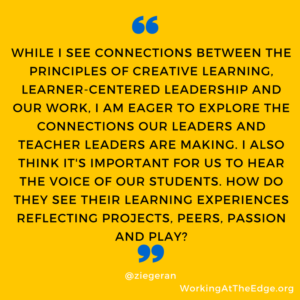 I’ve been thinking about learner-centered leadership and tinkering with ideas by mixing proposed principles of learner-centered leadership with ideas from other areas. Most recently, I looked at learner-centered leadership and exponential times. In this post, I pose some questions and share thoughts about learner-centered leadership and the principles of creative learning as embraced by the MIT Media Lab.
I’ve been thinking about learner-centered leadership and tinkering with ideas by mixing proposed principles of learner-centered leadership with ideas from other areas. Most recently, I looked at learner-centered leadership and exponential times. In this post, I pose some questions and share thoughts about learner-centered leadership and the principles of creative learning as embraced by the MIT Media Lab.
Learner-centered leadership
Recently, I wrote a post on learner-centered leadership in which I shared initial thoughts as my colleague and I dig deeper into the topic. Here were the main principles I shared:
- Leaders are always learners.
- There is no one way to be a learner-centered leader.
- Learner-centered leaders see and engage with everyone in the organization as a learner and a leader.
- The transformation of learning and leadership – from school-centered to learner-centered – has agency at its core.
Since articulating these four principles, I’ve been thinking quite a bit about future forecasting and the need for leaders to scan the current landscape, both inside and outside of education, and position the organization and its learners (both young and old) for success in a rapidly changing future. I’ve written a blog post and shared a podcast about the need to embrace future forecasting as a leadership competency. So let’s add this competency to our developing conceptualization of learner-centered leadership:
- Learner-centered leaders engage in future forecasting, engaging those in the organization to create the future.
Principles of Creative Learning
The MIT Media Lab operates on the idea that success in the future will be dependent on the ability of all learners to think and act creatively. After all, we live in exponential times where change is occurring more rapidly than ever before. With this in mind, the lab has articulated four principles known as the 4Ps of creative learning:
- Projects: People learn best when they are actively working on projects – generating new ideas, designing prototypes, making improvements, and creating final products.
- Peers: Learning flourishes as a social activity, with people sharing ideas, collaborating on projects, and building on one another’s work.
- Play: Learning involves playful experimentation – trying new things, tinkering with materials, testing boundaries, taking risks, iterating again and again.
- Passion: When people work on projects they care about, they work longer and harder, persist in the face of challenges, and learn more in the process.
Learn more about the principles and how the MIT Media Lab uses them in this video.
Bringing learner-centered leadership and creative learning together
One of the first things I noticed when I dove into the 4Ps were similarities to Education Reimagined’s five elements – Learning is: competency-based; personalized, relevant and contextualized; characterized by learner agency; socially-embedded; open-walled. Because of the similarities, it seemed natural to use the principles as a framework to reflect upon our own learner-centered leadership, asking the questions: In what ways are we engaging stakeholders in creative learning – projects, peers, play and passion? Would these ways be considered leading through a learner-centered paradigm?
In terms of our leadership practice in Salisbury, this year’s Leading #YourSalisbury project has elements of the four principles.
- The professional learning project involves nearly 25 teacher leaders, building leaders and central office leaders and is designed to develop a common understanding of our Profile of a Graduate and Learning Beliefs. Within the larger project, teams are working on specific building level projects/action plans and individual classroom projects.
- Because of the design of the collaboration, the Leading #YourSalisbury project is a social learning activity with abundant opportunities to work together and build on each other’s ideas and work, across and within building teams.
- Along the way, the team has experienced various degrees of success, characterized by tinkering, iterating and creating prototypes of learning models and projects that reflect various components of the Profile and Learning Beliefs.
- Conversations have been characterized by a passion for this work and an excitement for the changes in learning occurring in classrooms.
While I see connections between the principles of creative learning, learner-centered leadership and our work, I am eager to explore the connections our leaders and teacher leaders are making. I also think it’s important for us to hear the voice of our students. How do they see their learning experiences reflecting projects, peers, passion and play? More to come in future posts as I explore these questions more deeply!
How does your leadership reflect the 4Ps: projects, peers, play and passion? How does learning in the classroom reflect these principles?
Connect with Randy on Twitter and on the TLTalkRadio podcast!
Get new content delivered to your inbox and the ebook 3 Key Principles of Digital Transformation. The ebook contains valuable information from my experience leading a digital transformation and working with a variety of stakeholders over the past decade.
- A silver lining - January 22, 2022
- Is our use of tech working against us? 🤔 - September 8, 2021
- What’s NOT going to change in the next 10 years? 🤔 - September 7, 2021